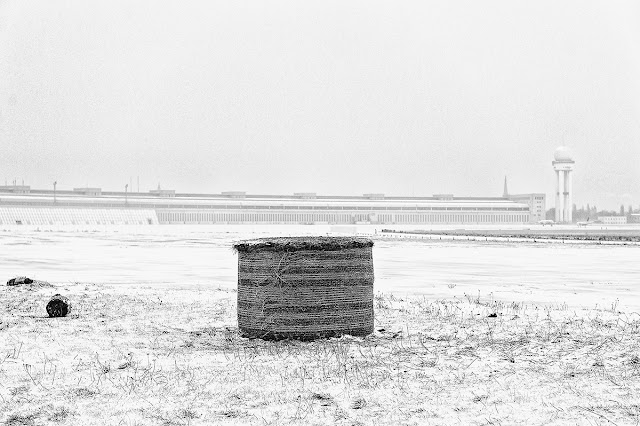Tempelhofer gardens
Germany, Berlin, January 16, 2013
Gardens during their wintersleep in wooden boxes at the former airport Tempelhof.
Berlin, a month ago
Berlin, December 20, 2012
Today's weather in the Netherlands reminds me of my first full day in Berlin, just now a month ago, when I explored the Tempelhof airport.
Berlin, 18-1-2013
Today I went to see the exhibition “Margaret Bourke-White. Photographs 1930 – 1945” at Martin-Gropius-Bau. Very moving are the photographs she took just after the liberation of the concentration camp Buchenwald and those of Jewish boys studying at the Talmuth school.
Since photographing was not allowed, I had to do it again, using the iPhone.
After seeing this impressive exhibition, I wandered around in the area of the Potzdammer Platz.
Tomorrow morning I will be going back home. So this is my last post from Berlin. The next one will come from Leiden, with more images of Berlin.
Köthenerstrasse
Linkstrasse
Potsdammer Platz
Subway station Mendelsohn Bartholdy
Berlin, 17-1-2013
Today I went to the Westend of Berlin to see the Unité d'Habitation by the famous Swiss architect Le Corbusier. He designed several Unités, which were all derived from his visionary 1922 city plan, known as Ville Contemporaine. The plan envisioned massive residential blocks set in open green areas—towers in parks, bringing light and air to the residents of urban housing. The plan was never realised.
The unité type was most notable for its creation of internal streets (essentially elaborate hallways) and accommodation of social and communal functions—kindergartens, medical facilities, recreational spaces—within the housing block. The Berlin unité, built between 1956-1959, lacks most of the amenities (save a shop and a post office on the ground floor).
Berlin, 16-1-2013
Today I went to Alt-Rixdorf in the Neuköln district, where protestant refugees from Bohemia settled in the eighteenth century. The remains of their village are still to be seen and give you the idea you've left the big city, which is around every corner. It was very nice and it took me some two hours to cover two streets.
Berlin, 15-1-2013
Today I went to the Treptower Park with the monument and burial place for the soldiers of the former Sovjet Union, who lost their lives during the battle of Berlin in 1945.
Later I took the bus to - I thought at least - the Stralau peninsula - to see some modern architecture I had seen on photos. Looking out of the window I suddenly recognised the park the bus just past by. It was the Schlesischer Busch in Kreutzberg, not far from the Cuvry Strasse, where I stayed in 2010.
At the end of the street there is a fallow field - a remainder of the waste land of the Wall, bordering the river Spree, that many favour to chill. To my surprise there were big teepees and all kinds of small tents on the field. I soon discovered people were living in the teepees. They are squatters who moved in in May 2012 to protest against the coming of the BMW Gugenheim Lab. Well, they were successful The lab moved to another part of Berlin. But they still stay at the Cuvry field to preserve it for the people of the neighbourhood and to prevent the building of expensive apartments, offices and a hotel, one of the squatters told me. It might lead to higher rents in the neighbourhood and more people who can't afford living in a decent flat. I wondered why they weren't chased away. That is quite simple. The police won't come into action when they are not payed to do so. The mayor won't pay, because the field is private property. The owner has no intention to pay either, since he thinks the city should do so.
Treptower Park: Russian war memorial
Schlesischer Busch with a watch tower - a remainder of the Wall
The Cuvry field
The Cuvry field
Berlin, 14-1-2013
Today I went to Oberschöneweide, where Emil Rathenau founded the Allgemeine Elektricitäts-Gesellschaft (AEG) or in the translation, General electricity company, in 1883. After the Second World War the AEG continued its business in West-Germany and the factories in Oberschöneweide were closed. The buildings that survived the war are still existing. Some beautifully restored, some almost in ruins and many decaying, but surviving and housing all kinds of small businesses.
Berlin, 13-1-2013
Today I went to the communal cemetery III of Schöneberg to visit the graves of Helmuth Newton and Marlene Dietrich.
Later on I went to the S-bahn station Insbrucker Platz to photograph the abandoned goods train station.
Berlin, 12-1-2013
Today I went to the Siemensstadt Housing Estate, which was built between 1929 and 1932 to house the workers in the Siemens factories. It is one the the six modernist housing estates in Berlin recognized by the UNESCO as a World Heritage Site.
Subscribe to:
Comments (Atom)





















































